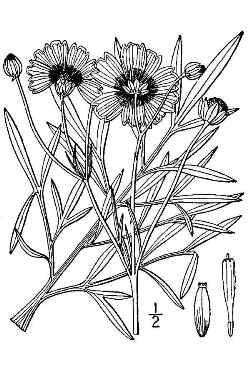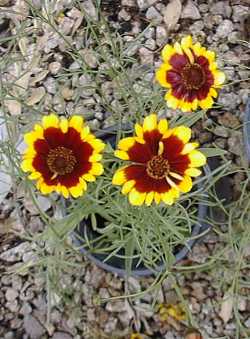Calliopsis, Annual Coreopsis, Plains Coreopsis
Scientific Name: Coreopsis tinctoria Nutt.
Synonym: Calliopsis tinctoria
Family: Asteraceae
Sunset®: All zones
USDA: 1-11
Heat Tolerance: Spring flower in Phoenix
Sun Exposure: Full sun
Origin: North America
Growth Habits: Upright annual, 2 to 3 feet tall (60 to 90 cm) or more, 1 feet spread (30 cm)
Watering Needs: Little water once established, good drainage
Propagation: Seeds in August to September.

Britton, N.L., and A. Brown. 1913. Illustrated flora of the northern states and Canada. Vol. 3: 493. Courtesy of Kentucky Native Plant Society.
Description
In the wild, the calliopsis is an annual forb which usually germinates in late summer or fall and overwinters as a rosette (round, low growing group of leaves). The stems begin growing upward and branching in April, reaching a height of up to 4 feet (there are dwarf varieties available). The opposite leaves are deeply divided, with the upper leaf segments being very narrow. The flowering heads are numerous, 1-2 inches in diameter, and are yellow with a red-brown center. They begin opening in May and continue flowering through July.
Uses
This plant is used mainly for landscape beautification. It has potential for use in cultivated, garden situations, in naturalized prairie or meadow plantings, and along roadsides. Calliopsis was introduced into Mississippi from the Western states, It is now considered a noxious weed in a few places. In gardens it brings color to flower beds and borders, and does well in meadow gardens.
Blooming Habits:
The Coreopsis has yellow daisy-like flowers, 2 to 3 inches wide (5-8 cm). They are excellent cut flowers. Keep picking them to push the plant to produce more.
Culture:
Calliopsis is adapted to many soil types. It grows best on a well-drained soil, but will not tolerate a very dry site. Natural stands are generally found on bottomland areas with ample moisture. It grows best in full sun, but will tolerate light shade.
Propagation:
A firm seedbed is required. Calliopsis germinates best on a clean tilled site that has been firmed with a roller or finishing harrow before planting. Seed can also be planted into a closely mowed, chemically-killed, or burned sod area with a light disking or harrowing that scratches the soil surface. A layer of plant residue on the soil surface can interfere with seed germination.
Planting Rate and Method
1-2 grams per 100 square feet (1-2 lb/acre) broadcast or shallowly drilled. Seed should be placed close to the soil surface. Cultipacking after planting will ensure good seed to soil contact. Seed will germinate soon after planting and remain as a rosette throughout the winter.
Fertilizer requirement
Plant growth and seed production are greatly improved by fertilization. Apply according to soil test recommendations. If not available, a rate of 3.5-5.5 oz per 100 square feet (100-150 lb/acre) of 13-13-13 should be applied in the spring before flowering.
Source: USDA, Natural Resources Conservation Service, Jamie L. Whitten Plant Materials Center
Desert-Tropicals is dedicated to provide gardening advice, gardening ideas, and information about flower of all kind for landscape and collections.We try to check carefully the identification of the plants on the illustrations as well as the other information from the page, but occasionally errors do occur. if you notice anything that needs to be changed please contact us.Thanks.
© 1998-2020 Philippe Faucon, All Rights Reserved.
